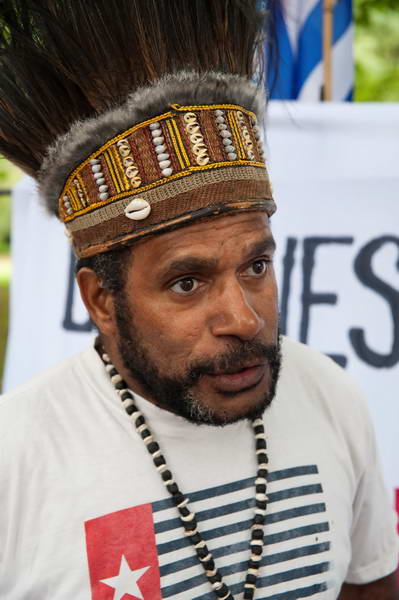Photographing people from other cultures is something that I think always requires a degree of humility from photographers, and I find the work of Jimmy Nelson disturbing. In yesterday’s Guardian, John Vidal writes about the criticism of his work by indigenous people and Survival International, and I share the views that he relates. Nelson seems to regard the people he photographs as models to be used to illustrate his own fantasies, which are largely unrelated to their own lives and to promote himself as a photographer. Ethnic fashion rather than ethnography. As well as quoting Stephen Corry, the director of Survival International, Vidal also gives the view of Benny Wenda, who I’ve met and photographed on several occasions, protesting about the persecution of his people by the Indonesian regime.

Benny Wenda protesting at the Netherlands embassy calling for the promised free elections in West Papua
In his very expensive book, Corry says Nelson describes Wenda’s Dani as a “dreaded head-hunting tribe”, while Wenda states “My people, the Dani people, were never headhunters, it was never our tradition. The real headhunters are the Indonesian military who have been killing my people.”
I’ve not seen Nelson’s exhibition, but was sorry to miss the protest outside it by Nixiwaka, an Amazon Indian from the Yawanawá tribe, which you can read about on his blog at Survival International.
For a look at some real photography of peoples from various parts of the world, I’d recommend some time on the web site of Giles Perrrin, who I first met when he showed me his work in Birmingham in 2007. There is a sensitivity in his work, whether in Detroit, Veille Aure, Ethiopia or anywhere else around the world that seems entirely lacking in Nelson’s fashion plates.
And another interesting cross-cultural show, one I’ve not seen but only read about, is taking place in Coventry, and continues until 11 January 2015 at the Herbert Museum. ‘Photographs of India’, work by Coventry by based photographer Jason Scott Tilley from 1999 and 2009 is augmented by work from his Anglo-Indian grandfather Bert Scott, who worked for the Times of India from 1936-40 and headed the Indian Army photographic unit in Burma during the Second World War.
Also on show are pictures from the collection of the Library of Birmingham of images of Indian people published in eight volumes between 1868 and 1875 by the India Office in London and containing 470 original photographic prints, an expression of the “British government’s desire to create a visual record of ‘typical’ physical attributes and characteristics of Indian people to help them understand the population of the newly-acquired colony“. You can view this remarkable work in its entirety on the New York Public Library Digital Gallery.